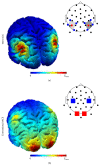Transcranial Alternating Current and Random Noise Stimulation: Possible Mechanisms
- PMID: 27242932
- PMCID: PMC4868897
- DOI: 10.1155/2016/3616807
Transcranial Alternating Current and Random Noise Stimulation: Possible Mechanisms
Abstract
Background. Transcranial alternating current stimulation (tACS) is a relatively recent method suited to noninvasively modulate brain oscillations. Technically the method is similar but not identical to transcranial direct current stimulation (tDCS). While decades of research in animals and humans has revealed the main physiological mechanisms of tDCS, less is known about the physiological mechanisms of tACS. Method. Here, we review recent interdisciplinary research that has furthered our understanding of how tACS affects brain oscillations and by what means transcranial random noise stimulation (tRNS) that is a special form of tACS can modulate cortical functions. Results. Animal experiments have demonstrated in what way neurons react to invasively and transcranially applied alternating currents. Such findings are further supported by neural network simulations and knowledge from physics on entraining physical oscillators in the human brain. As a result, fine-grained models of the human skull and brain allow the prediction of the exact pattern of current flow during tDCS and tACS. Finally, recent studies on human physiology and behavior complete the picture of noninvasive modulation of brain oscillations. Conclusion. In future, the methods may be applicable in therapy of neurological and psychiatric disorders that are due to malfunctioning brain oscillations.
Figures





References
Publication types
MeSH terms
LinkOut - more resources
Full Text Sources
Other Literature Sources
Medical
Research Materials

